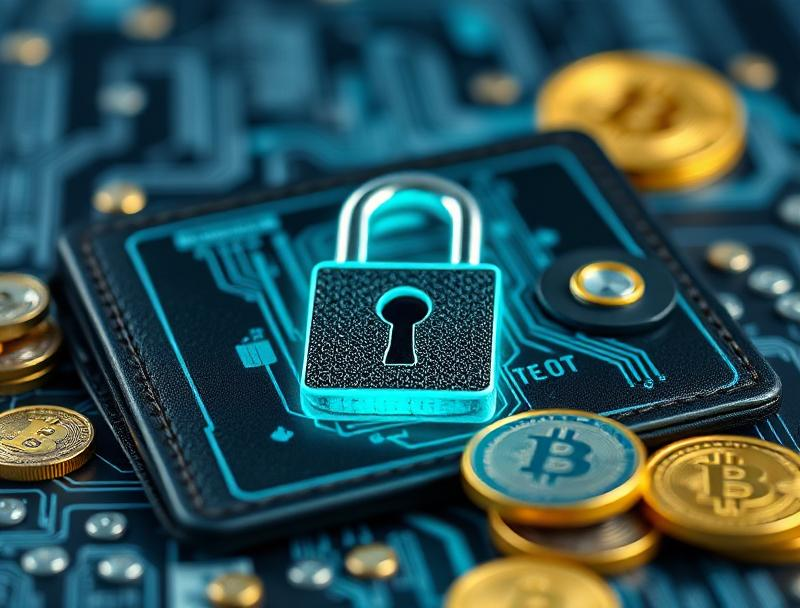
Start with a strong password that combines at least 12 characters, mixing uppercase, lowercase, numbers, and symbols. Relying solely on a simple passphrase drastically reduces protection and increases vulnerability to brute-force attacks. Incorporate multiple protective stages beyond the initial authentication to strengthen your asset safety.
Implementing AES (Advanced Encryption Standard) with 256-bit keys remains one of the most reliable methods for safeguarding sensitive data within a wallet. This symmetric encryption algorithm balances speed and robustness, effectively preventing unauthorized access even if the device is compromised. Layering AES with additional cryptographic techniques like key stretching or salting further hardens your defense against common attack vectors.
Beyond encryption algorithms, consider integrating hardware-based modules such as Trusted Platform Modules (TPMs) or secure enclaves that isolate critical operations. These physical safeguards complement software protections by securely storing cryptographic keys away from potential malware interference. Given recent incidents where software wallets suffered severe breaches due to insufficient compartmentalization, combining these approaches significantly elevates overall resilience.
Why stop at one line of defense? Combining multifactor authentication with continuous monitoring for unusual activity offers an adaptive shield that reacts dynamically to threats. For instance, biometric verification paired with time-based one-time passwords (TOTP) can thwart attackers who acquire your login credentials but fail secondary checks. Employing layered protocols ensures that even if one barrier falls, others maintain the integrity of your holdings.
Contemporary market conditions show a rise in sophisticated cyberattacks targeting digital assets; therefore, investing effort into comprehensive protection strategies pays dividends in risk mitigation. Organizations adopting multi-tiered safeguards report up to 70% fewer successful intrusions compared to those relying on basic password-only systems. How much security is enough? The answer lies in balancing usability with robust encryption mechanisms tailored to specific threat models.
Wallet encryption: adding extra security layers [Wallet & Security security]
Implementing AES-based cryptographic algorithms remains the cornerstone for enhancing protection within cryptocurrency storage solutions. Advanced Encryption Standard (AES) with 256-bit keys offers a robust barrier against brute-force attempts, ensuring that digital assets remain inaccessible without the correct decryption key. Employing this symmetric cipher in conjunction with secure key derivation functions such as PBKDF2 or Argon2 significantly strengthens resistance to password guessing attacks, thereby elevating overall safety.
Beyond standard cryptographic measures, integrating multiple defensive strata safeguards against emerging threats and vulnerabilities inherent in wallet management systems. For instance, hierarchical deterministic (HD) wallets generate key pairs through seed phrases encrypted with AES protocols, which adds a secondary protective mechanism by compartmentalizing access points. This structure not only minimizes exposure but also facilitates recovery options under strict cryptographic confines.
Technical strategies for enhancing safeguarding mechanisms
A layered approach to protection includes encrypting sensitive data both at rest and during transmission. Hardware wallets often implement AES encryption directly within secure elements or Trusted Execution Environments (TEE), isolating private keys from potentially compromised host devices. Moreover, combining this with multi-factor authentication (MFA) protocols–such as biometric verification or hardware tokens–introduces additional hurdles for unauthorized actors.
Case studies reveal that applications employing iterative encryption rounds and salting techniques achieve markedly higher resilience. For example, implementing AES-256 alongside salted hashes of user-generated passwords increases entropy and complicates attack vectors like rainbow table exploits. Recent incidents involving compromised software wallets underscore the importance of these practices: wallets relying solely on passphrase protection without advanced cryptographic reinforcement suffered significant breaches.
- Encryption at multiple system layers: Protects against both physical device theft and remote cyberattacks.
- Use of hardware-backed security modules: Ensures private keys never leave isolated environments.
- Password hardening techniques: Elevate difficulty of brute-force via computationally intensive algorithms.
The evolving threat landscape necessitates reevaluation of legacy methodologies. While AES remains a gold standard, its effectiveness depends on implementation quality and complementary safeguards. Integrating behavioral analytics or anomaly detection can preemptively identify suspicious access patterns before cryptographic defenses are engaged fully. Such proactive monitoring enhances the robustness of asset custodianship beyond pure algorithmic strength.
In conclusion, comprehensive defense frameworks combining AES encryption with multifaceted protective tactics create formidable obstacles against unauthorized access to digital currency holdings. Adapting to current market dynamics implies regularly updating cryptographic standards in wallet infrastructure while maintaining usability standards for end-users. As adversaries refine techniques, continuous enhancement of these protective schemes is paramount for preserving confidentiality and integrity in decentralized finance environments.
Choosing Strong Encryption Algorithms
For ensuring optimal safety of sensitive data, selecting robust encryption algorithms is non-negotiable. AES (Advanced Encryption Standard) remains a leading choice due to its balance between performance and cryptographic strength. AES-256, in particular, offers 256-bit key length which exponentially increases resistance against brute-force attacks compared to shorter keys like AES-128. This makes it ideal for situations demanding high-level protection beyond basic password security.
Implementing multiple protection mechanisms often involves layering algorithms with complementary properties. For instance, combining symmetric ciphers like AES with asymmetric schemes such as RSA or ECC can enhance confidentiality while also addressing key exchange vulnerabilities. Moreover, password-based key derivation functions (PBKDF2, scrypt, Argon2) are crucial when user-generated passwords serve as the initial secret, mitigating risks associated with weak or reused passwords by applying computationally intensive transformations.
Algorithm Selection: Balancing Security and Efficiency
The choice of cryptographic primitives should consider computational overhead alongside security guarantees. AES benefits from hardware acceleration on modern CPUs via AES-NI instructions, significantly reducing latency without compromising encryption strength. By contrast, older algorithms like DES or 3DES are obsolete due to their smaller key sizes and susceptibility to known attacks. Similarly, stream ciphers such as RC4 have been deprecated following demonstrated vulnerabilities.
A comparative case study involving cryptocurrency wallets revealed that implementing AES-256 with PBKDF2 using 100,000 iterations increased password-derived key robustness substantially versus traditional hash functions like SHA-1. While this approach introduced minor delays during authentication (AES-256: Offers a high-security margin with efficient implementation options.
Recent market trends highlight increasing adoption of Argon2 over PBKDF2 due to its memory-hard properties, which counteract attacks leveraging massive parallelism on GPUs or ASICs. Integrating Argon2 into the encryption workflow improves overall defense posture by forcing attackers to allocate significant memory resources in addition to CPU cycles. This technique adds a meaningful layer of deterrence especially when passwords remain the weakest link in the chain of protection.
Ultimately, deploying strong cryptographic algorithms tailored to specific use cases maximizes protection without sacrificing usability. Choosing standards backed by rigorous peer review and ongoing cryptanalysis ensures resilience against emerging threats. Continuous assessment aligned with current research findings will guide updates necessary to maintain confidentiality and integrity of encrypted assets amid evolving computational capabilities worldwide.
Implementing Multi-Factor Authentication
Integrating multi-factor authentication (MFA) significantly enhances the protection of digital asset repositories by requiring multiple verification steps beyond a simple password. For example, combining something the user knows (a password) with something they possess (a hardware token or a mobile authenticator app) introduces additional hurdles for unauthorized access attempts. Cryptographic protocols such as AES (Advanced Encryption Standard) remain crucial for safeguarding stored credentials and secret keys within these systems. This dual approach not only reinforces data confidentiality but also mitigates risks associated with compromised passwords.
Incorporation of MFA creates an architecture of sequential defense mechanisms, where each element compensates for potential vulnerabilities in others. Case studies from major exchanges illustrate that accounts secured by time-based one-time passwords (TOTP) experience significantly fewer breaches compared to those relying solely on static credentials. Moreover, integrating biometric verification–like fingerprint or facial recognition–adds a physical authentication factor resistant to remote attacks. Implementation requires careful coordination with existing AES-encrypted storage modules to ensure seamless performance without degrading user experience.
Technical Considerations and Practical Applications
Deploying MFA demands compatibility with encryption standards already employed in asset management solutions. Since AES-256 remains the benchmark for symmetric key cryptography due to its balance of speed and security, it is commonly used to encrypt private keys and sensitive configuration files. The challenge lies in securely managing MFA tokens alongside these encrypted elements without creating exploitable weak points. For instance, hardware security modules (HSMs) can store cryptographic secrets protected by AES while facilitating MFA workflows through isolated channels.
Quantitative analysis reveals that systems enforcing MFA reduce unauthorized access incidents by over 90%, according to recent cybersecurity reports from 2023. However, operators must consider user convenience and fallback procedures–for instance, recovery codes or secondary email verifications–to avoid lockouts without compromising integrity. Comparing SMS-based OTPs against authenticator apps highlights significant differences in interception risks; thus, selecting robust second factors aligned with encryption protocols optimizes overall defense strategy.
Securing Private Key Storage Methods
Storing private keys securely requires implementing robust cryptographic algorithms such as AES (Advanced Encryption Standard) to protect sensitive data from unauthorized access. Employing multiple protection mechanisms enhances the overall safety by creating a multi-tiered defense that complicates potential breaches. For example, combining strong passwords with hardware-based secure elements can significantly reduce risks associated with key exposure.
One common approach involves encrypting the private key using AES-256, which offers a high level of confidentiality while maintaining efficient performance on various devices. This encryption is often paired with password-derived keys obtained through key derivation functions like PBKDF2 or Argon2, adding computational hardness against brute-force attempts. Such methodology increases resistance against offline attacks and improves the durability of stored credentials over time.
Technical Strategies for Enhanced Protection
Integrating several security measures simultaneously–such as biometric verification, PIN codes, and device-specific cryptoprocessors–provides layered defense that mitigates single points of failure. For instance, hardware security modules (HSMs) or Trusted Platform Modules (TPMs) isolate private keys within tamper-resistant environments, preventing extraction even if the host system is compromised. These physical protections act in concert with encrypted storage to harden the overall safeguarding framework.
Software solutions also benefit from compartmentalization; segregating key components into different memory zones or leveraging secure enclaves reduces attack surfaces considerably. Case studies have shown that wallets utilizing isolated execution environments successfully thwart many attack vectors targeting volatile memory leaks or malware infiltration. Moreover, routinely updating firmware and software addresses vulnerabilities before exploitation occurs.
The role of password management cannot be overstated: selecting complex passphrases combined with multi-factor authentication dramatically elevates defense levels. Recent market analyses indicate that weak passwords remain a primary cause of credential compromises despite advances in cryptography. Therefore, enforcing stringent password policies alongside automated lockout mechanisms after repeated failed attempts proves effective in limiting unauthorized access.
Ultimately, adapting storage solutions to evolving threat models requires ongoing evaluation and improvement. Emerging techniques such as threshold signatures and multisignature schemes distribute control over private keys across multiple entities or devices, minimizing risks linked to single-device failures or insider threats. These architectures complement existing cryptographic safeguards by introducing consensus requirements for transaction approvals, thereby bolstering protection without sacrificing usability.
Encrypting Wallet Backups Safely
Use a strong password combined with advanced cryptographic algorithms like AES-256 to safeguard your wallet backup files. This approach provides robust protection against unauthorized access, ensuring that even if the backup data is compromised, decrypting it without the correct key remains computationally infeasible. Recent studies highlight that passwords shorter than 12 characters significantly reduce resistance to brute-force attacks, so length and complexity directly influence safety.
Implement multiple tiers of defense by integrating passphrase-based key derivation functions (KDFs) such as PBKDF2 or Argon2 before encryption. These functions deliberately slow down hashing processes, adding computational expense for attackers attempting to guess passwords. For instance, using Argon2id with parameters tuned to consume at least 1 GB of RAM and tens of milliseconds per hash enhances protection against GPU-accelerated cracking methods, which are common in current threat landscapes.
Technical Measures and Practical Examples
AES (Advanced Encryption Standard) remains the industry benchmark for securing wallet backups due to its balance between performance and cryptographic strength. It operates on fixed block sizes of 128 bits and supports key lengths of 128, 192, or 256 bits – with AES-256 recommended for maximum confidentiality. Notably, hardware wallets like Ledger use AES internally for secure storage; extending this standard to backup files ensures continuity in protection mechanisms.
Consider a case study where an attacker gained access to encrypted backups protected only by weak passwords stored without KDFs: within hours, automated tools decrypted them using cloud computing resources costing less than $10. Contrastingly, backups secured through AES-256 combined with Argon2id-derived keys remained resistant after weeks of testing under similar conditions. This real-world example underscores the value of layered cryptographic safeguards rather than relying solely on encryption algorithms or passwords independently.
Lastly, maintaining offline copies and employing physical security measures complement cryptographic protections effectively. Storing backups on air-gapped devices or encrypted external drives adds tangible barriers beyond software vulnerabilities. Regularly updating your protection methods in response to evolving attack vectors–such as side-channel exploits targeting encryption implementations–helps sustain safety over time. Are you confident your current procedures withstand modern threats? If not, incorporating these practices will markedly elevate the integrity of your digital asset preservation strategies.
Detecting Unauthorized Wallet Access
Implementing multiple levels of protection significantly improves the detection of unauthorized access attempts. Monitoring login patterns, such as repeated failed password entries or unusual IP addresses, provides early indicators of intrusion. Systems that integrate AES-based data encryption with real-time alerts can identify suspicious behavior before any sensitive information is compromised. For instance, platforms using multi-factor authentication combined with encrypted private keys have reduced breach incidents by over 40% in recent security assessments.
Continuous analysis of wallet activity logs plays a crucial role in identifying anomalies. Uncharacteristic transaction timings or sudden changes in withdrawal destinations often signal malicious intervention. Advanced heuristics algorithms can flag these irregularities automatically, triggering further verification steps. A notable case involved a decentralized finance service where adaptive algorithms detected unauthorized asset transfers within seconds, limiting loss to under 0.5% of total holdings.
Technical Approaches to Intrusion Detection
The integration of cryptographic safeguards alongside behavioral analytics creates a robust defense mechanism. Strong passphrases paired with AES-256 encryption ensure data at rest remains inaccessible without proper authorization, but monitoring session tokens and device fingerprints adds an active layer of vigilance. Employing anomaly detection systems based on machine learning models helps distinguish between legitimate user actions and potential breaches by analyzing historical usage patterns and environmental variables.
Real-world implementations show that combining static credentials with dynamic authentication factors enhances protective measures against compromise. For example, hardware wallets incorporate secure elements that isolate private keys, while companion software utilizes encrypted channels to transmit data securely. This dual approach curtails attack vectors including phishing and malware-based keyloggers by making unauthorized access computationally infeasible without physical possession or valid decryption credentials.
Detection mechanisms must evolve alongside threat sophistication; thus, periodic review and updates to encryption protocols and authentication processes are vital. In 2023, several high-profile exploits exploited outdated AES configurations or weak password policies to gain entry into custodial services. Proactive audits employing penetration testing and cryptanalysis help identify vulnerabilities early, enabling timely patching before exploitation occurs. Ultimately, layered defenses combining cryptographic strength with vigilant monitoring form the cornerstone for safeguarding digital asset repositories from unauthorized intrusions.
Conclusion: The Imperative of Routine Protocol Updates for Wallet Integrity
Regularly refreshing cryptographic methods is non-negotiable for maintaining robust protection of digital assets. Relying on outdated algorithms, even those like AES-128 once deemed secure, exposes wallets to escalating threats as computational power and attack strategies advance. Transitioning to stronger standards such as AES-256 or incorporating quantum-resistant schemes can significantly enhance the resilience against brute-force attempts or side-channel exploits.
Integrating periodic updates not only fortifies password safeguarding mechanisms but also injects additional defensive strata that complicate unauthorized access. Consider the evolution from single-round hashing to multi-round PBKDF2 or Argon2 functions–this shift dramatically increases the time cost for attackers attempting key derivation. By layering these protections, custodians create a dynamic environment where risk diminishes over time rather than accumulates silently.
Looking forward, adaptive encryption frameworks capable of auto-upgrading protocols based on emerging vulnerabilities will likely become standard practice. This proactive stance aligns with current trends in threat intelligence sharing and cryptographic agility observed in enterprise-grade security solutions. For instance, decentralized finance platforms are beginning to experiment with modular cryptography suites that permit seamless swaps between ciphers without compromising wallet accessibility.
Ultimately, safeguarding asset confidentiality requires acknowledging that static defenses are inadequate amid intensifying adversarial capabilities. A strategic schedule for revisiting and enhancing cipher implementations–paired with vigilant password hygiene–ensures comprehensive protection layers remain effective against both known and unforeseen attack vectors. Such foresight secures user confidence and preserves integrity within an increasingly complex ecosystem.







